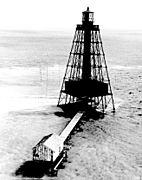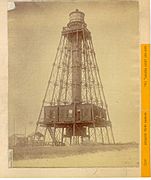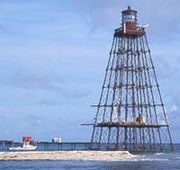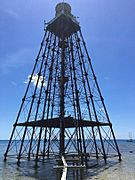Sand Key Light facts for kids
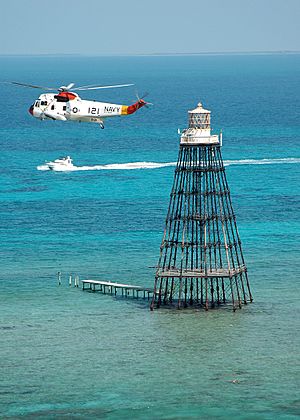 |
|
| Sand Key Light, 2005 | |
| Location | southwest of Key West, Florida |
|---|---|
| Coordinates | 24°27′14″N 81°52′39″W / 24.45389°N 81.87750°W |
| Year first lit | 1853 |
| Automated | 1938 |
| Deactivated | 2015 |
| Foundation | cast iron screw piling |
| Construction | cast iron |
| Tower shape | square pyramidal skeletal tower |
| Focal height | 109 feet (33 m) |
| Original lens | first order Fresnel lens |
| Range | White 14 nautical miles (26 km; 16 mi), Red 11 nautical miles (20 km; 13 mi) |
| Characteristic | Flashing (2) white 15s with red sectors |
| Racon | "N" (— ∘) |
| Admiralty number | J3006 |
| ARLHS number | USA-724 |
| USCG number | 3-1055 |
The Sand Key Light is a lighthouse located about 6 nautical miles (11 km) southwest of Key West, Florida. It stands between two important channels that lead into Key West: Sand Key Channel and Rock Key Channel. The lighthouse is built on a reef that is sometimes covered by sand.
This sandy area, called a "key," has changed a lot over time. Sometimes, it was big enough to have trees. In 1900, thousands of tern birds even nested there. Other times, the island has completely disappeared under the waves.
Contents
Early Lighthouse History
The very first light to help ships near Sand Key was a brick tower. It was 60 feet (18 meters) tall and built in 1827. The first person to look after the light, called a keeper, was John Flaherty.
After John died in 1830, his wife, Rebecca Flaherty, took over the important job. In 1844, a strong hurricane hit the area. It washed away part of the island and destroyed the keeper's house. The storm also damaged the protective wall around the lighthouse.
The Great Havana Hurricane
A very powerful storm, known as the Great Havana Hurricane of 1846, struck the area. This hurricane was so strong that it knocked down the brick lighthouse tower. Sadly, Rebecca Flaherty and five other people died in this terrible storm.
Building a New Lighthouse
The same hurricane that destroyed the Sand Key Light also destroyed the Key West Lighthouse. To make sure ships could still find their way, a ship named the Honey was turned into a lightship. This temporary lighthouse floated near Sand Key until new, permanent lighthouses could be built.
It took some time for the U.S. Congress to approve money for the new lighthouses. This was because the Lighthouse Board, which managed lighthouses, was being reorganized.
A Stronger Design
Work on a new lighthouse for Sand Key began in 1852. This new lighthouse would use a special screw-pile foundation. This type of foundation uses large iron screws drilled deep into the seabed, making the structure very stable.
However, the builders ran out of money before the foundation was finished. The company building it had to wait seven years to get their final payment. Later that same year, Lieutenant George Meade was put in charge of building the Sand Key Light. He had just finished building the Carysfort Reef Light.
The new Sand Key Light tower was completed in 1853. This lighthouse was special because it was the first to use a new type of hydraulic lamp designed by George Meade himself.
Surviving the Storms
The strong screw-pile foundation and the open, skeletal design of the tower helped the lighthouse survive many hurricanes. In 1856, another hurricane completely washed away all of the island that was above water. But the lighthouse stood strong!
The Sand Key Light became automated in 1938. This meant that a keeper no longer needed to live there to operate the light. In 1967, the large, original Fresnel lens was removed and replaced with a smaller one. This smaller lens was then replaced in 1982 with a modern flash tube system.
Recent Changes
In 1989, a fire badly damaged the lighthouse tower. The light had to be moved to a temporary structure nearby. In 1995, people tried to repair the tower's structure. However, the old keeper's living quarters were torn down in 1996.
The light was finally moved back into the main tower in 1998. The Sand Key Light was turned off, or deactivated, in 2015. Today, the lighthouse is being offered for sale through GSA Auctions.
Gallery


